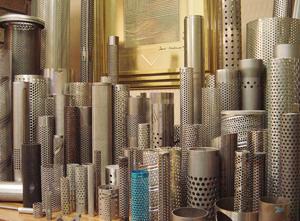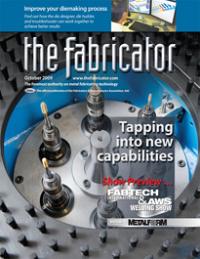- FMA
- The Fabricator
- FABTECH
- Canadian Metalworking
Categories
- Additive Manufacturing
- Aluminum Welding
- Arc Welding
- Assembly and Joining
- Automation and Robotics
- Bending and Forming
- Consumables
- Cutting and Weld Prep
- Electric Vehicles
- En Español
- Finishing
- Hydroforming
- Laser Cutting
- Laser Welding
- Machining
- Manufacturing Software
- Materials Handling
- Metals/Materials
- Oxyfuel Cutting
- Plasma Cutting
- Power Tools
- Punching and Other Holemaking
- Roll Forming
- Safety
- Sawing
- Shearing
- Shop Management
- Testing and Measuring
- Tube and Pipe Fabrication
- Tube and Pipe Production
- Waterjet Cutting
Industry Directory
Webcasts
Podcasts
FAB 40
Advertise
Subscribe
Account Login
Search
Perfecting processing for perforated products
Laser eliminates crooked cuts, burrs
- By Eric Lundin
- September 6, 2009
- Article
- Laser Cutting
Most tubes and pipes have just two holes, one in each end, and manufacturers do everything they can to prevent any other holes from appearing in their products. Welded tube manufacturers put quite a bit of effort into preventing pinholes, cold welds, lap welds, and other flaws that could result in ventilation points along the weld seam.
And then there are tube and pipe producers like Beverlin Manufacturing Corp. Beverlin, located in Grand Rapids, Mich., manufactures lengths of tubing with additional holes. Many, many additional holes. Holes that are made intentionally. Consistently sized holes in regular patterns.
"We manufacture straight- and spiral-welded perforated tubing," said Mike Watson, manufacturing engineer.
The company works with carbon steel, stainless steel, electrogalvanized steel, tinplated steel, and aluminum. It handles materials from 0.010 to 0.135 in. thick; tube diameters from 3/16 to 36 in. OD; and tube lengths up to 15 ft. The three most common hole patterns available are straight-line, 45-degree (diagonal), and 60-degree (staggered) (see Figure 1).
Cutting Versus Cutting Efficiently
Manufacturing perforated tubing is one thing; cutting it is another; cutting it efficiently is yet another.
Beverlin used to cut tubing with a band saw. It's well-known that a band saw is one of the most efficient machines for cutting tube or pipe to length. However, when it comes to perforated products, it's difficult to get a straight cut.
"The blade follows the path of least resistance," Watson explained. "In other words, it follows the perforations." Because the blade would wander quite a bit from a straight line, Beverlin had to take quite a few extra steps to square the ends.
"We used to cut the product too long, then grind one end to make it square, then grind the other end to make it square and to get the part down to the specified length," Watson said. "Then we'd deburr it, package it, and ship it. This was labor-intensive and resulted in too much waste," he added.
Beverlin tried cold sawing. The process itself provided a straight cut, but the clamping needed to hold the part steady caused deformation and the sawing process left a burr.
"We had to re-form the tube, then deburr it," Watson said. Again, not efficient.
Beverlin's research concluded that laser cutting would provide a straight cut without ancillary problems. The parts would have square ends, would be cut to the correct length, and wouldn't require deburring.
The company chose an LC24 from AltaMAR Laser & Control. The machine is based on the company's LT2400 (a laser tube machine that handles 24-ft. lengths), but it is a simpler model that handles round tube only. The machine is equipped with a 2,000-W laser from PRC Laser Corp., a focusing head and optics from Haas Laser Technologies, and a proprietary control system based on Delta Tau hardware. Building systems from off-the-shelf parts helps to minimize the waiting time for replacement components and simplifies maintenance and repairs.
However, this isn't an off-the-shelf machine. AltaMAR supplies machines that handle 12- or 24-ft. lengths, so Beverlin had to choose between a system that was too short to handle its longest workpieces or too long to fit into its existing plant layout. AltaMAR split the difference and designed an 18-ft. system. Because Beverlin does 90-degree cuts only, the builder saw an opportunity to customize the system further by automating and optimizing some of the setup functions, so changeover from one tube size to another takes about five minutes. Another modification addressed the smoke generated from the cutting processes.
"The standard system vacuums the smoke from the tube's ID," Watson said. It's impossible to establish a vacuum in perforated tubing, so AltaMAR came up with a system that blows the smoke out of the tube so a ventilation hood can capture it.
After the machine was delivered, Beverlin saw an opportunity for yet another modification, one that reduces material waste. Nearly every cutting process results in some waste; in this case, the wasted material was an 8-in. length, or drop, out of every stick. The fabricator designed its own fixture and got the waste material down to a 2-in. drop.
But all the modifications really were just the icing on the cake. The cake itself was increased throughput and more floor space.
"When we relied on band sawing, some parts required 17 minutes to cut, grind, and deburr," Watson said. "Using the laser, which eliminates grinding and deburring, we can process the same parts at a rate of two to three parts per minute. We also reclaimed some floor space when we got rid of some of our old equipment," he said.
The Power of Empowerment
What does it take to program and run a laser? You don't need much direct experience according to Angel Esparza, Beverlin's lead laser programmer (see Figure 2). He had never programmed or run a laser machine before coming to work at Beverlin, but he had learned about working with metals at another company, an aluminum components manufacturer. He also had some formal education in computer science. But that's all.
"I had taken some computer programming classes, but it was nothing like this," Esparza said. "When I first got here, I was afraid to touch the machine," he said, chuckling at the memory.
Some training from AltaMAR helped, as did his can-do attitude. So far he has accumulated more than two years of laser experience at Beverlin, programming, operating, and troubleshooting the machine.
"He could probably give AltaMAR's staff a few tips now," Watson said with a smile.
About the Author

Eric Lundin
2135 Point Blvd
Elgin, IL 60123
815-227-8262
Eric Lundin worked on The Tube & Pipe Journal from 2000 to 2022.
subscribe now

The Fabricator is North America's leading magazine for the metal forming and fabricating industry. The magazine delivers the news, technical articles, and case histories that enable fabricators to do their jobs more efficiently. The Fabricator has served the industry since 1970.
start your free subscription- Stay connected from anywhere

Easily access valuable industry resources now with full access to the digital edition of The Fabricator.

Easily access valuable industry resources now with full access to the digital edition of The Welder.

Easily access valuable industry resources now with full access to the digital edition of The Tube and Pipe Journal.
- Podcasting
- Podcast:
- The Fabricator Podcast
- Published:
- 04/16/2024
- Running Time:
- 63:29
In this episode of The Fabricator Podcast, Caleb Chamberlain, co-founder and CEO of OSH Cut, discusses his company’s...
- Trending Articles
How to set a press brake backgauge manually

Capturing, recording equipment inspection data for FMEA

Tips for creating sheet metal tubes with perforations

Are two heads better than one in fiber laser cutting?

Hypertherm Associates implements Rapyuta Robotics AMRs in warehouse

- Industry Events
16th Annual Safety Conference
- April 30 - May 1, 2024
- Elgin,
Pipe and Tube Conference
- May 21 - 22, 2024
- Omaha, NE
World-Class Roll Forming Workshop
- June 5 - 6, 2024
- Louisville, KY
Advanced Laser Application Workshop
- June 25 - 27, 2024
- Novi, MI



























